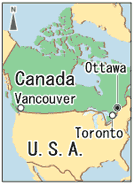(25)A-bomb survivors and peace activists in Canada by Satoko Norimatsu
Learning from the experiences of Hiroshima and Nagasaki, the people of Canada are actively involved in peace-building efforts. One acquaintance of mine, a school teacher, uses a popular book about Sadako Sasaki in her classes. And the city where I live, Vancouver, is one of the 63 member cities in Canada that belong to "Mayors for Peace," an anti-nuclear weapons organization led by the mayors of Hiroshima and Nagasaki.
Kinuko Laskey, an atomic bomb survivor of Hiroshima, was a popular figure in peace education in Vancouver until she passed away in 2004. She shared her experience of the bombing and showed how to fold paper cranes at schools and gatherings in the area. Thanks to the efforts of her husband, David, the city has declared every August 6th "Hiroshima Day." And last year on August 4-5, at an annual Japanese-Canadian summer festival called the "Powell Street Festival," the Mayor of Vancouver, Sam Sullivan, read out an appeal for the abolition of nuclear weapons. I heard that 18 cities across Canada held events related to the atomic bombings at that time of year.

Participants make paper cranes at the A-Bomb Exhibition in Vancouver. Third from the right is Mayor Sam Sullivan and seated next to him is David Laskey. (photo by Arc Han in August 2007)
Satoko Norimatsu
Born in Tokyo, she moved to Canada 11 years ago. Founder of Peace Philosophy Centre and a member of "Vancouver Save Article 9." She took part, as an interpreter, in a visit to Hiroshima and Nagasaki with students of Japan and the United States.
In conjunction with the "Powell Street Festival," an atomic bomb exhibition was held in Vancouver. It was organized by a group called "Vancouver Save Article 9," which was founded in 2005 with the aim of preserving Article 9 of the Japanese Constitution (banning the state from waging war) and promoting the ideal of Article 9 to the world. This group staged a reading of the well-known A-bomb play, "The Face of Jizo," written by Hisashi Inoue. At the same time, they opened their exhibition, "Atomic Bombs and Human Beings," with photos provided by the Japan Confederation of A- and H-Bomb Sufferers Organizations.

At last year's exhibition, a display involving military comfort women was included with photos about the bombings. This was due to the fact that many immigrants from Asia live in Vancouver and, out of respect for a balanced presentation, it was felt that Japan's wartime role should be conveyed along with the bombings of Hiroshima and Nagasaki. As expected, many media outlets took interest in the event.
At a ceremony in Toronto on October 26, 2007, Setsuko Thurlow, an A-bomb survivor from Hiroshima, received "The Order of Canada" for her peace efforts over many years. This honor is one the highest awards given to ordinary citizens by the Canadian government. And in Vancouver, it has been decided that a statue of Kinuko Laskey will be placed in Seaforth Peace Park.
In these ways, the story of Hiroshima has been shared by survivors, peace activists, and educators all over Canada. I, too, want to play my part.